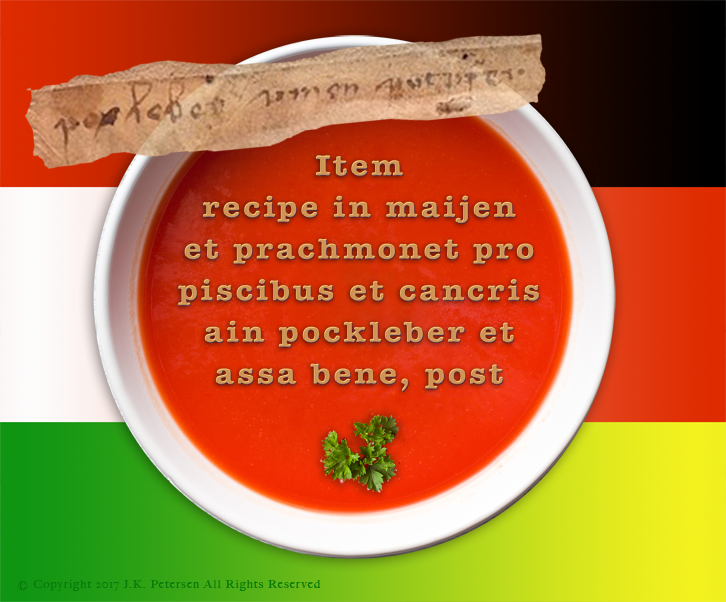It’s a challenge to read old manuscripts. Language has changed, writing styles were very different, a bewildering array of abbreviations occupies each sentence like a mine field, and there were no spelling checkers (or hard-and-fast rules about spelling) in the 15th century. To complicate matters, scribes often copied manuscripts in languages they didn’t fully understand.
The last page of the VMS reads like a cryptic alphabet soup, but are texts with blended languages that unusual?
Support for Billy Goat Liver?
My gut feeling, even before investigating it, was that blended languages were bound to occur in societies where a second language was an essential tool of commerce and scholarly correspondence. But a sixth sense and real data are two different things, so I kept my eyes open for an unambiguous example and found one, and inside was the most surprising Easter egg, something I never expected…
BSB CGM 8137 is a tract on fishing and has no obvious connection to the VMS, but the recipes use many of the same ingredients as folk medicine, so it reads very much like a medical manuscript. It mentions tormentilla, wine, beer and “pockleber” (goat liver)—that was the surprise! Finding goat liver is not particularly unusual, but finding goat liver in a manuscript that blends languages in such a quirky way made me sit up and take notice…
As far as I’m aware, no one has mentioned CGM 8137 “pockleber” in connection with the VMS, but it’s important because it demonstrates that this ingredient was used in ways other than cooking and might relate to the words written at the top of folio 116v. The spelling is different, but substituting “x” (Greek chi) for hard-h, ch, or ck was not unusual and “p” was often used where modern German uses “b”.
If poxleber and pockleber refer to the same thing, then this manuscript offers evidence to support the interpretation offered by Johannes Albus and anyone else who may have read the text as “goat liver”.
I was happy to find this example for two reasons:
• it offers evidence that pockleber (both the word and the ingredient) was probably in use in the 15th century, and
• the script is an excellent example of mixed language. CGM 8137 demonstrates that macaronic text was in practical use.
I’ve long wondered if some of the not-quite German words on f116v that are mixed with readable German might be fractured Latin (mixed in with accepted Latin) and that some of the text on the second line might even be Spanish. Here is an excerpt from fishing recipe #12 to give an idea of how intimately languages could be blended. Note also that the interpretation of “pockleber” as a compund word is unambiguous, as “leber” is mentioned again, by itself, on the fourth line:
Item rec[ipe] mayen et prachmonet pro piscib[us] et cancris ain pockleber et assa bene, pus?post? assacionem sparge desuper pulverem de gaffer. Postea? recipe das kalbs netzlen oder schaff netzlen das da frisch ist, und schlags umb die leber. Postea liga super asserem parvulum ad capiendum pisces et cancros…
The first word, “Item”, was widely used in both German and Latin, and “recipe” is middle French for “medical prescription”. Then there’s an odd combination of month names, the first Latinesque (mayen), the other German (prachmonet) (note that once again, a “p” has been substituted for “b”). Brachmonat is June in German, and calendars illustrating the month’s labors often illustrate June as a farmer tilling his fields. The next four words are Latin, followed by two German words (ain pockleber), and three more in Latin instructing the reader to dry or roast well.
The month names really caught my eye. You would think the writer would choose one language or the other for related concepts in the same sequence, but apparently there was no impulse to organize the languages this way.
The other recipes are interlaced in the same way.
It’s significant that German and Latin are mixed not just line-by-line (as in macaronic verse) or phrase-by-phrase, but sometimes word-by-word.
That’s the important part. If “pox leber” turns out to be German and even if “pfer” at the end turns out to be a German word like “pferd” that doesn’t mean the words in between have to be German. If CLM 8137 is any example, the word “um?n” and some of the German-looking words on the last line could be Latin (or something else).
The Possibilities…
 CGM 8137 was created about a century after the VMS, so it’s not an exemplar, but “goat liver” was no doubt a common phrase—goats were an integral part of medieval society—which means that other examples might be found, as additional manuscripts are scanned and read.
CGM 8137 was created about a century after the VMS, so it’s not an exemplar, but “goat liver” was no doubt a common phrase—goats were an integral part of medieval society—which means that other examples might be found, as additional manuscripts are scanned and read.
This isn’t proof that “pox leber” says goat liver, there may be other interpretations, but it is greatly intriguing, especially considering polyglot manuscripts have been found to exist.
J.K. Petersen
© Copyright 2017 J.K. Petersen, All Rights Reserved



Nice find, JKP. This is why I leave the marginalia to others, I would have totally read that as porkleber (which is without any doubt more palatable than goat liver :))
It certainly looks like “porkleber”, rather than “pockleber”, and might be read that way if it stood alone, but there are more than 100 pages of example letters to help us learn the scribe’s writing style. Words like “prachmonet”, “schaff”, “assacionem”, and “capiendum” all have a “c” that resembles a modern “r”.
Unfortunately, VMS 116v provides very little context. Each word is included only once, and not all the letters of the alphabet are represented. Detective work is our only tool for puzzling out the text.
-JKP –
I’d be interested to read more about your interesting comment:
“substituting “x” (Greek chi) for hard-h, ch, or ck was not unusual”
Could you give some references for further reading on this?
Diane, I know this from reading manuscripts. I’m mainly interested in primary sources, so I’m not able to recommend articles.
On the subject of substitutions and Greek origins…
In Carolingian and medieval manuscripts, there were several forms of “s”, including straight-s, long-s, Greek sigma, a dee-shaped “s”, and the “s” we use today. In the 14th and 15th centuries, the long-s was often used in the same word with Greek sigma (which was frequently used as ess at the ends of words). Sometimes sigma was erratically used with other forms of “s” in the same manuscript, sometimes even in the same sentence, such as the “s” that resembles a “d” (a transitional shape in which the tail of the Greek sigma is curled around to make the second ess curve).
The ess is a morphological substitution, but there were also phonological substitutions…
In Middle German, “a” is frequently substituted for “e” (as in ain), “p” is substituted for “b” (as in “puch” for “buch”) and “x”, from Greek, is sometimes used (somewhat erratically) rather than converting it to “ch” or “ck”. The Greek chi (x) has been adapted into other languages in a variety of ways. Sometimes the “x” shape is retained, but more often it is written as a hard-h (similar to Hebrew hard-h), or as ch (similar to Scottish “loch”) or written as ck or k as we usually do in English. In medieval manuscripts, it was very common for “ch” and “ck” to be substituted for one another and less common for “x” to be used, but it occurs, so it’s not unreasonable for researchers to suggest that “pox” (pock/bock) could be read as “goat”, especially when it is combined with a common German word like “leber/leben”.
That is called “Code Switching”, a not at all unusual phænomenon in medieval writing. The thing is, while it happens all the time invonluntarily, it can also be used on purpose, as in “Lingual Obfuscation”. The “Sforza Kanzlei Chiffre” (Cod. Vindob. 2398) is a good example. It certainly impedes statistical methods if _one underlying language is assumed.